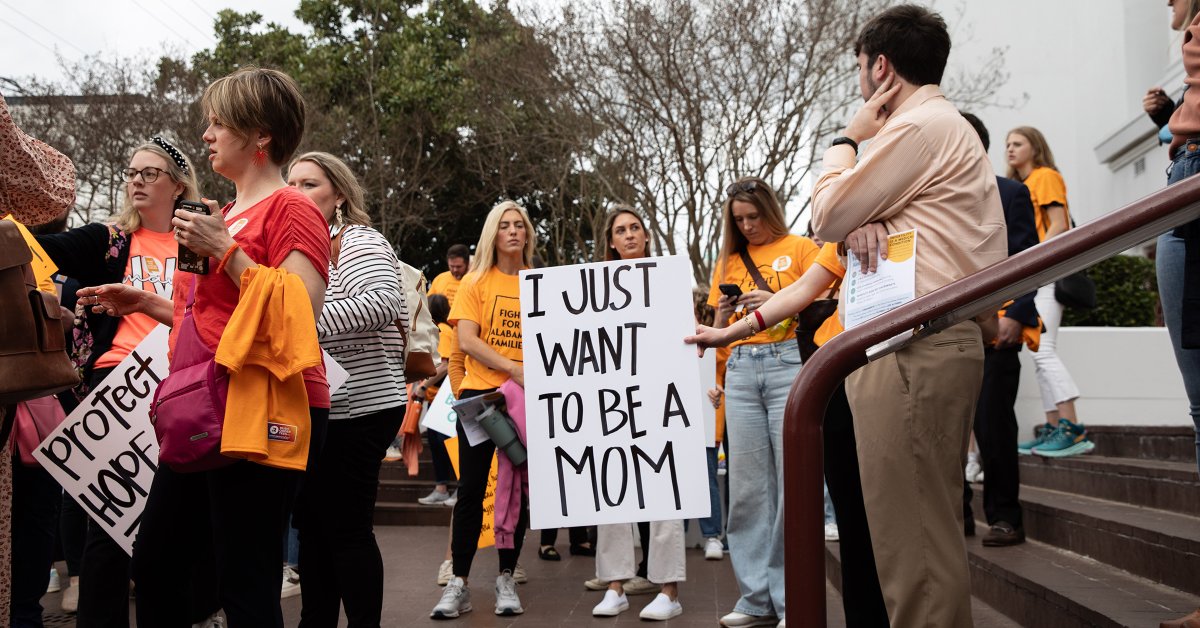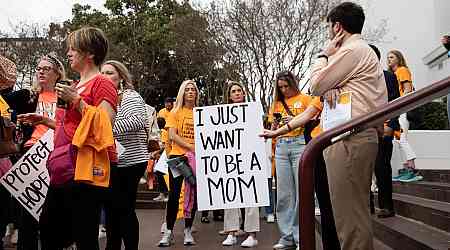
In February, a horrified Elizabeth Carr scrolled through headline after headline about a pause on in vitro fertilization (IVF) procedures in Alabama. The Alabama Supreme Court had ruled that frozen embryos have the legal rights of children, a decision that meant fertility providers could feasibly face prosecution if they destroyed one. Rather than take that risk, some fertility clinics halted IVF services entirely.
[time-brightcove not-tgx=”true”]Carr, who in 1981 became the first baby in the U.S. born using IVF, felt like “an endangered species.” When Carr was born, IVF—a process of fertilizing eggs outside a woman’s body, then implanting a resulting embryo in her uterus—was new and largely unknown. Carr’s parents, who desperately wanted children but struggled to have them naturally, were willing to face public scrutiny and repeatedly travel from their home in Massachusetts to a pioneering clinic in Virginia to try the cutting-edge procedure. IVF’s success for the Carrs led not only to their daughter’s historic birth, but also compelled Elizabeth to become an advocate for reproductive rights when she grew up. Over those recent days in February, when patients in Alabama were shut out of fertility clinics, Carr acutely felt the importance of her work. Moments like those, she says, are “why we advocate so loudly.”

After public outcry and bipartisan pushback, Alabama lawmakers quickly passed protections for IVF providers, and services resumed. But IVF is still under attack.
Despite the backlash, judges in Alabama declined to reconsider their controversial ruling. And more than a dozen other U.S. states have laws in place that could be interpreted as bestowing personhood rights on an embryo, even if it has not yet resulted in a pregnancy. Courts in other states haven’t yet applied these laws in ways that directly threaten IVF—although Louisiana law forces fertility providers to ship embryos out of state for destruction—but the possibility is there if the wrong case comes before the wrong judge, says Rebecca Reingold, an associate director at the O’Neill Institute for National and Global Health Law at the Georgetown University Law Center.
Right now, it is politically unpopular to attack IVF, a technology that has given life to millions of people and hope to some of the one in six adults worldwide with infertility. Only 8% of U.S. adults actively oppose access to IVF, according to recent polling, and even lawmakers from states that have cracked down on abortion, like Texas, have introduced bills to protect IVF.
And yet, in June, Republican senators—including former President Donald Trump’s current running mate, J.D. Vance—voted against a bill that would have established a federal right to IVF care. The same month, members of the Southern Baptist church voted to oppose the use of IVF, a decision that has no legal ramifications but signals a growing willingness among religious conservatives to embrace prenatal personhood concepts that effectively place IVF in the same category as abortion.
How did we get here? And where are we going?

Growing anti-IVF sentiment
The concept of prenatal personhood isn’t new, but it has historically been unpopular. In a 2013 legal journal article, reproductive-rights expert Maya Manian argued that’s because “public concern over the ‘side effects’ of personhood laws”—such as infringing on fertility care, contraception access, and women’s health care more broadly—“seems to have persuaded even those opposed to abortion to reject personhood legislation.” It was, in other words, a step too far for most people.
In a relatively short span of time, however, the idea has gone from “radical or fringe” to one that is gaining ground, Reingold says. It has even transcended the anti-abortion movement, with ex-spouses in some cases using the concept to argue that frozen embryos should be treated by the courts as children, not marital property, during divorce proceedings. As such ideas snowball, IVF may become the next frontier in the battle over reproductive rights, advocates and scholars say.
Read More: The Silent Shame of Male Infertility
“It’s clear to us—it always has been—that the anti-abortion movement has not, and will not, stop their efforts at limiting or banning abortion,” says Karla Torres, who leads the nonprofit Center for Reproductive Rights’ work on assisted reproductive technology. They are “squarely targeting reproductive freedom more broadly,” drawing everything from IVF to contraception into the fray.
If IVF becomes harder to access, it’s hard to overstate the effect for American families and culture at large. About 2% of babies born in the U.S. in recent years—nearly 100,000 annually—arrived with the help of IVF. But the technology’s impact transcends statistics. In about a half century of use, it has reshaped what it means to be a parent, who gets to be one, and how—progress that’s now under threat.

A confusing position
In some ways, IVF is an unlikely target. The technology enables people to have badly wanted biological children, a sentiment that could be seen as having a “conservative traditional family aspect to it,” says Amanda Roth, an associate professor of philosophy and women’s and gender studies at the State University of New York at Geneseo. The importance of having children is a regular conservative talking point—see: Vance recently calling child-free women “cat ladies” without a “direct stake” in the future of America—and IVF makes it possible for more people to do that.
But many in the anti-abortion movement argue that life begins at the moment of conception—that is, the moment sperm fertilizes an egg to create an embryo, either the old-fashioned way or in a laboratory. (A fertilized egg is considered an embryo until the end of the 10th week of pregnancy, when it becomes a fetus.)
To that effect, about a third of U.S. states currently have laws that establish prenatal personhood rights at some stage of pregnancy, usually as a means of curtailing access to abortion by establishing that terminating a pregnancy is tantamount to killing a child. Nine of these laws, such as those in Arkansas, Kansas, and Tennessee, are either sweeping enough or vaguely worded enough that they could put IVF services at risk, according to analysis from the nonprofit Pregnancy Justice provided to TIME. Six additional states, including the Dakotas, Michigan, and Oklahoma, have either feticide or wrongful death laws broad enough to potentially apply to embryos. And there’s always the possibility of new laws: already in 2024, more than a dozen bills focused on prenatal personhood have been introduced across the U.S.
Read More: The Abortion Fight Isn’t a ‘War on Women.’ It’s a War on Poor Women
Greer Donley, an associate professor at the University of Pittsburgh School of Law who studies abortion law, doesn’t think curtailing access to IVF is a “priority” for the anti-abortion movement, but rather an “unfortunate side effect that [anti-abortion advocates] haven’t been able to account for.” It’s a narrative problem: to argue an embryo in a mother’s womb is a person, but one sitting in a fertility clinic freezer isn’t, would weaken the movement’s argument. So, despite the cognitive dissonance, IVF has become “collateral damage” in the abortion wars, Donley believes.

Whether the situation was intentional or not, threats to IVF are real. The Alabama Supreme Court demonstrated as much in February, when it ruled that the state’s Wrongful Death of a Minor Act applies to not-yet-implanted embryos, prompting fertility clinics to pause IVF services for fear that patients or providers could be legally liable if embryos were destroyed in the course of care. That’s not an irrational fear: embryos are destroyed all the time in the fertility world, either purposely (perhaps because a patient no longer wishes to pay for storage, or because the embryo is unlikely to result in a healthy pregnancy) or because of human error.
Accidents happen, says Dr. Gerard Letterie, a reproductive endocrinologist at Seattle Reproductive Medicine who has written about the potential impact of fetal personhood laws on clinicians. An embryo could be destroyed through an innocent mistake, like someone tripping while carrying a petri dish. “If that were to be made a felony charge, that’s a big deal,” Letterie says.
In that scenario, clinics might stop services entirely to avoid putting providers in legal jeopardy, as happened in Alabama. Or, even if services proceeded, providers might stop practicing in states with punitive laws, Letterie says, making access to fertility care as scattershot as access to abortion care. Already, fertility clinics tend to be clustered in wealthier urban areas.
Read More: Why It’s So Hard to Have Your Fertility Tested
Even short of criminal charges for providers, prenatal personhood laws could affect fertility practices, Letterie says. He can imagine policies that limit the number of eggs that may be fertilized per cycle to avoid creating extra embryos that ultimately end up discarded. Such policies—the likes of which have already been implemented elsewhere in the world, such as in Malta—could reduce the odds of patients getting pregnant, since not all embryos are viable, and force people to go through more rounds of treatment, making IVF more expensive and inaccessible than it already is. IVF can already cost upward of $10,000 per cycle without insurance, and coverage varies by state and insurance provider. If costs go up even more, Letterie says, IVF would be inaccessible to virtually everyone who isn’t mega-wealthy or lucky to have excellent health insurance.
Even taking finances out of the picture, threats to IVF have particularly high stakes for certain people. Those who stand to lose the most are those for whom IVF has been revolutionary over its half century of use: namely same-sex couples, people with medical infertility, and those who have decided to have children without a partner or later in life. “The existence of reproductive technologies has opened up new horizons for family life,” says Marcia Inhorn, a medical anthropologist at Yale University and author of Motherhood on Ice: The Mating Gap and Why Women Freeze Their Eggs. In a future without reliable access to IVF, the possibilities of what families can look like might shrink.

A crossroads for U.S. culture
IVF and other fertility services helped break open the narrow definition of family that dominated for so long—a married man and woman and their naturally conceived children—to reveal a whole world of options. A mother can be 45 and single, even if she’s survived cancer or had her fallopian tubes removed or needs to use a donor egg to get pregnant. Same-sex couples can use “reciprocal” IVF to incorporate both of their genetic material. A child can even have three biological parents, a controversial technique that is not currently legal in the U.S. but is in several other countries.
“We’ve seen a significant diversification in how people understand kinship, relatedness, and parenting,” says Sarah Franklin, who directs the Reproductive Sociology Research Group at the University of Cambridge in the U.K.
This progress has not been equally felt around the world. Compared to the U.S., Europe and Asia have historically employed stricter regulations on the use of reproductive technologies like IVF. Although some of those policies have loosened in recent years, single and older women, trans and non-binary people, and/or same-sex couples are still barred from using reproductive technologies in countries including China, Poland, Turkey, and Italy. And in many poorer countries, including most of the ones in Africa, there is next to no access to IVF at all.
Even in the U.S., where IVF is much more broadly used, reproductive medicine has not wiped out persistent stereotypes and social norms, says Arthur Greil, a professor emeritus at Alfred University in New York and author of Not Yet Pregnant: Infertile Couples in Contemporary America. People are willing to pay IVF’s exorbitant fees, at least in part, because society still emphasizes the importance of a genetic relationship between parent and child, Greil says. And, he says, the knee-jerk assumption is still that a child has both a mother and father. “If you are a single woman with a child, people just assume that you must have been divorced,” Greil says. “It’s become impolite to ask questions like, ‘Where is the baby’s father?’ But people still have the questions.”
Read More: I Was Told I Was Too Fat to Freeze My Eggs
Still, IVF has made what was once impossible—or, at the very least, difficult or done outside the scope of mainstream medicine—possible for many people. Sex, age, and medical diagnoses don’t necessarily close the road to biological parenthood anymore; they are just speed bumps. Reproductive technologies are expensive and imperfect, working only about half the time in the best circumstances and becoming even less of a sure bet among patients who are older or relying on donated embryos. But it has made the possibility of biological parenthood real for swaths of the population that, a century ago, would have had zero or few options. “Fertility medicine has made all of us parents-in-waiting,” says Laura Mamo, a professor of public health at San Francisco State University who studies the intersection of sexuality and medicine.
The trickle-down effects can be seen throughout U.S. culture. Women, no longer so pressured by biological clocks to end their careers just as they’re advancing, now outnumber men in the college-educated workforce, and some employers offer fertility benefits to entice workers to stay longer. People are getting married later, if ever, freed from the need to settle for an imperfect partner to have a family. Queer parenthood is on the rise, and same-sex couples are making fertility equality a new social-justice issue, fighting for fair treatment by insurance providers and clinicians. Scientific advances in fertility medicine, like the ability to pick embryos by sex, are even raising important new bioethical dilemmas.
IVF is not solely responsible for those shifts—Franklin sees it more as a “mirror” reflecting major societal changes and conditions—but it plays a part. Making the technology harder or impossible to access, then, would have profound effects on countless people, particularly those from marginalized groups. And that, Mamo says, may be exactly the point for some people pushing forward the prenatal personhood movement.
“It’s not really about personhood,” Mamo says. “It’s really about this expansion of gender and family and sexuality and autonomy over people’s bodies.”

Fighting back
Already, legislators and reproductive-rights advocates are preparing for battle. In his first speech as Kamala Harris’ vice presidential running mate, Minnesota Gov. Tim Walz reaffirmed his commitment to protecting reproductive health care including IVF, a technology that he and his wife used to have their daughter, Hope. “When Vice President [Harris] and I talk about freedom, we talk about the freedom to make your own health care decisions,” Walz said.
Elsewhere, the Center for Reproductive Rights has for years been working with partner advocacy groups and legislators to expand access to IVF by implementing new state policies around fertility coverage and broadening those that already exist, which are often written in ways that exclude same-sex couples or people who aren’t cisgender. That work is continuing in earnest, Torres says. And in the aftermath of the Alabama decision, lawmakers in at least a dozen states introduced bills meant to either protect IVF providers from liability or specify that embryos outside the human body do not legally qualify as people, according to the Guttmacher Institute, a reproductive-rights nonprofit. A broader package of pro-IVF bills moved forward at the federal level before being blocked by Republican senators in June.
Along with legislative solutions, the reproductive-rights movement is also trying to develop legal defenses that can be used to stop prenatal personhood arguments in court, says Donley, the Pittsburgh law professor. Judges may hold long-term appointments and don’t necessarily need to win elections—which means some can stray from public opinion with fewer consequences than elected officials. “I feel confident right now that the politics of reproductive rights are such that Republican legislatures aren’t going to pass anti-IVF bills,” Donley says. “Republican judges are another story. They get to do whatever they want.”
Read More: ‘I Don’t Have Faith in Doctors Anymore.’ Women Say They Were Pressured Into Long-Term Birth Control
That means people who want to protect IVF access will need compelling legal arguments, says Georgetown’s Reingold. One, she says, could be pointing out the slippery slope of prenatal personhood. If an embryo is considered a person in one legal context, it could be considered one in many: a pregnant person could arguably claim their embryo as a tax dependent, a beneficiary for public assistance, or (in a lower-stakes scenario) another person for the purposes of driving in a carpool lane. Pointing out “consequences for other areas of the law that haven’t necessarily been completely thought through” could be an effective strategy for limiting the influence of fetal personhood arguments, Reingold says.
Another possible consequence: if an embryo is legally considered a person, a pregnant person could feasibly be criminalized for a miscarriage or pregnancy complication, says Kulsoom Ijaz, a senior staff attorney at Pregnancy Justice. Ijaz says she’s “cautiously optimistic” that pointing out such dystopian ripple effects would sway some judges and lawmakers. “It’s a matter of summoning defiant hope so that we…make sure there is no more rollback on people’s most basic civil and human rights,” she says.
There is some precedent to back Ijaz’ optimism. Even in the 2022 U.S. Supreme Court decision that overturned Roe v. Wade, the justices did not take a position on “if and when prenatal life is entitled to any of the rights enjoyed after birth,” which could foreshadow a broader hesitation for judges throughout the U.S. court system to consider questions of legal personhood.
That reluctance may not last forever. But in the meantime, IVF advocates like Carr, the first U.S. person born using the technology, are leaning on some of the “best tools” they have: their own stories, which underscore how life-changing IVF can be for individuals, couples, and families. “I always knew there were people who didn’t agree with how I was born. Around age 10, I realized I can potentially educate people,” Carr says. “I feel very strongly, and I always have, that people fear things they don’t understand.”
The stakes of that education campaign are high. Carr’s birth was a historic first for the U.S. “I do not want to think about who could potentially be the last,” she says.






























